Material Performance and Animal Clinical Studies on Performance-Optimized Hwangtoh Mixed Mortar and Concrete to Evaluate Their Mechanical Properties and Health Benefits
Abstract
:1. Introduction
2. Material Properties of Activated Hwangtoh Mixed Concrete
2.1. Reaction Mechanism
| Component | Unit Mass Percentage (%) | |
|---|---|---|
| Hwangtoh | Cement | |
| SiO2 | 57.7 | 22.0 |
| Al2O3 | 29.5 | 5.80 |
| Fe2O3 | 6.32 | 3.30 |
| K2O | 3.54 | – |
| TiO2 | 1.12 | – |
| MgO | 1.06 | 1.20 |
| F | 0.22 | – |
| CaO | 0.126 | 64.04 |
| Na2O | 0.114 | – |
| P2O5 | 0.0620 | – |
| MnO | 0.0518 | – |
| SO3 | 0.0434 | – |
2.2. Calculating the Replacement Ratio of Activated Hwangtoh
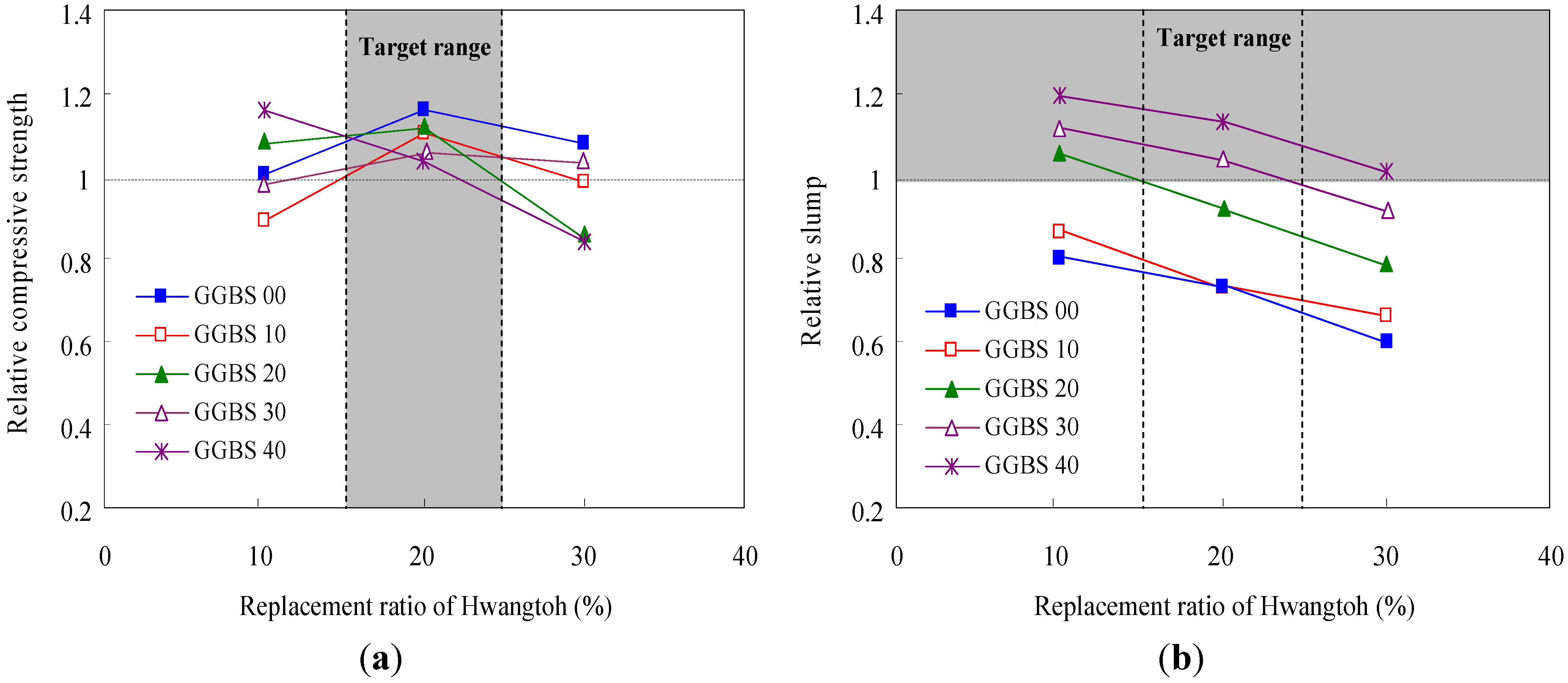
2.3. Slump Test
| Water-to-binder ratio (%) | Hwangtoh replacement ratio (%) | Plasticizer (%) | Slump (cm) |
|---|---|---|---|
| 45 | Control | – | 13 |
| 20 | – | 3.5 | |
| 1 | 6 | ||
| 1.5 | 9–10 | ||
| 2 | 15–18 |
2.4. Compressive Strength
| Specimen | Unit (kg/m3) | ||||||
|---|---|---|---|---|---|---|---|
| W | C | S | G | HT | GGBS | F | |
| Control | 176 | 409 | 679 | 1034 | – | – | – |
| G 5F25 | 204.5 | 81.8 | 20.45 | 102.3 | |||
| G10F20 | 40.9 | 81.8 | |||||
| C15F15 | 61.35 | 61.35 | |||||
| G20F10 | 81.8 | 40.9 | |||||
| G25F 5 | 102.3 | 20.45 | |||||
| Specimen | Unit (kg/m3) | ||||||
|---|---|---|---|---|---|---|---|
| W | C | S | G | HT | GGBS | F | |
| Control | 176 | 391 | 681 | 1042 | – | – | – |
| G 5F25 | 195.5 | 78.2 | 19.55 | 97.75 | |||
| G10F20 | 39.1 | 78.2 | |||||
| C15F15 | 58.65 | 58.65 | |||||
| G20F10 | 78.2 | 39.1 | |||||
| G25F 5 | 97.75 | 19.55 | |||||
| Specimen | Unit (kg/m3) | ||||||
|---|---|---|---|---|---|---|---|
| W | C | S | G | HT | GGBS | F | |
| Control | 176 | 352 | 694 | 1062 | – | – | – |
| G 5F25 | 176 | 70.4 | 17.6 | 88 | |||
| G10F20 | 35.2 | 70.4 | |||||
| C15F15 | 52.8 | 52.8 | |||||
| G20F10 | 70.4 | 35.2 | |||||
| G25F 5 | 88 | 17.6 | |||||
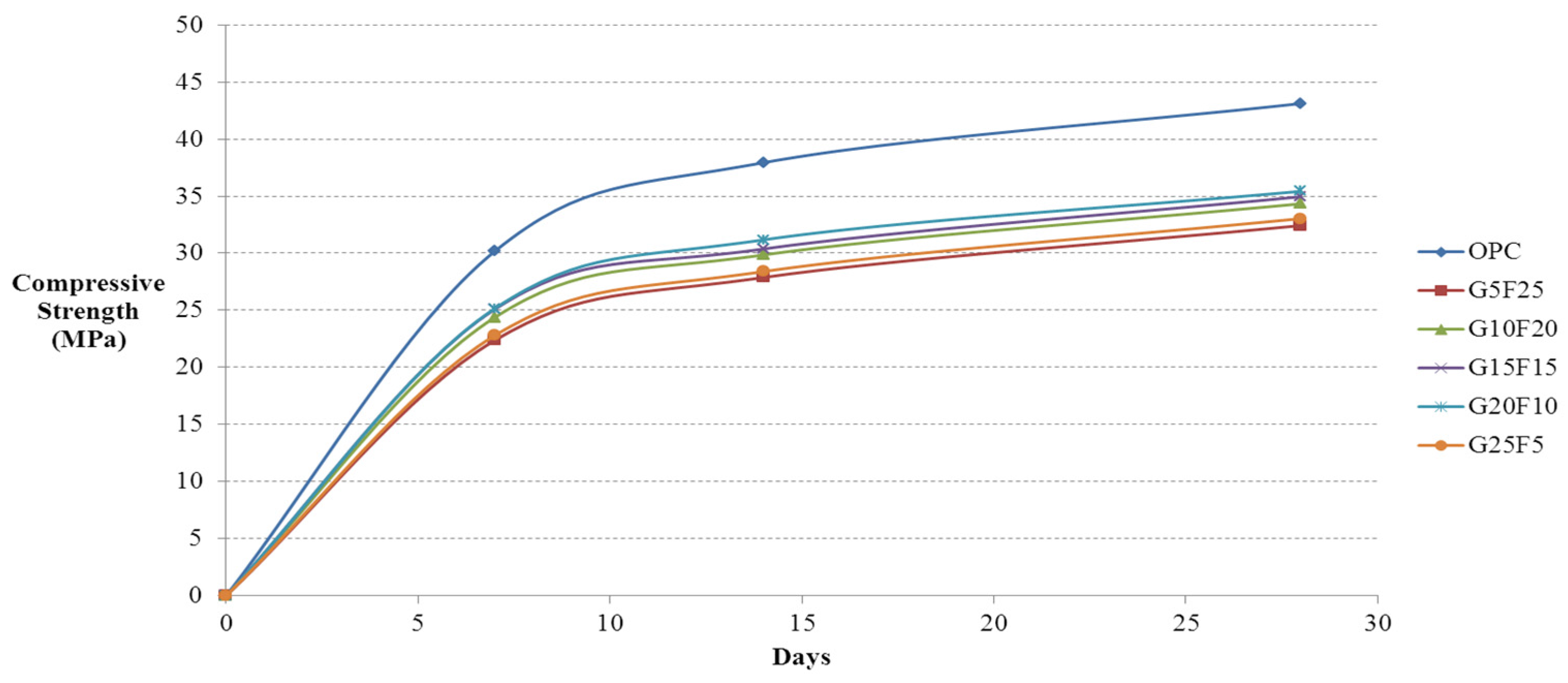
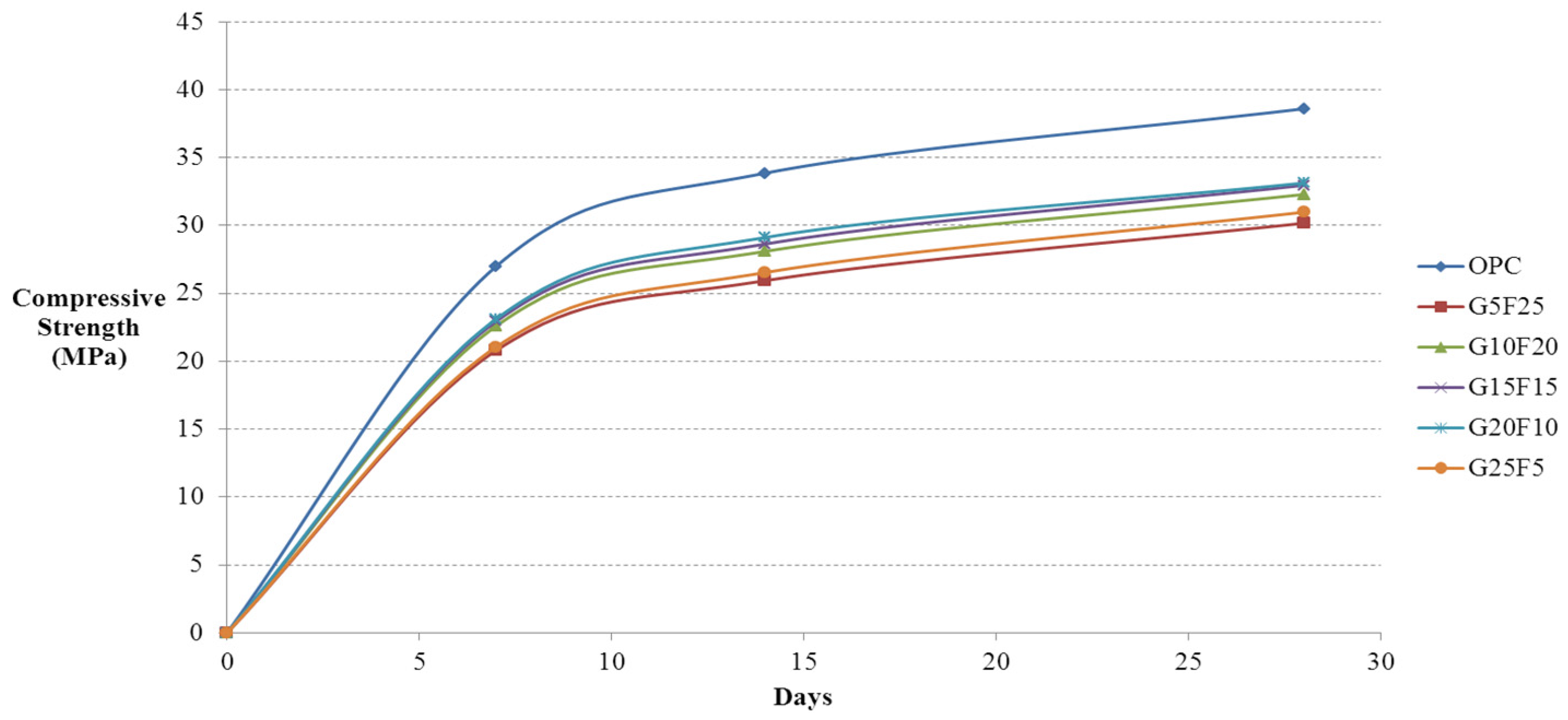

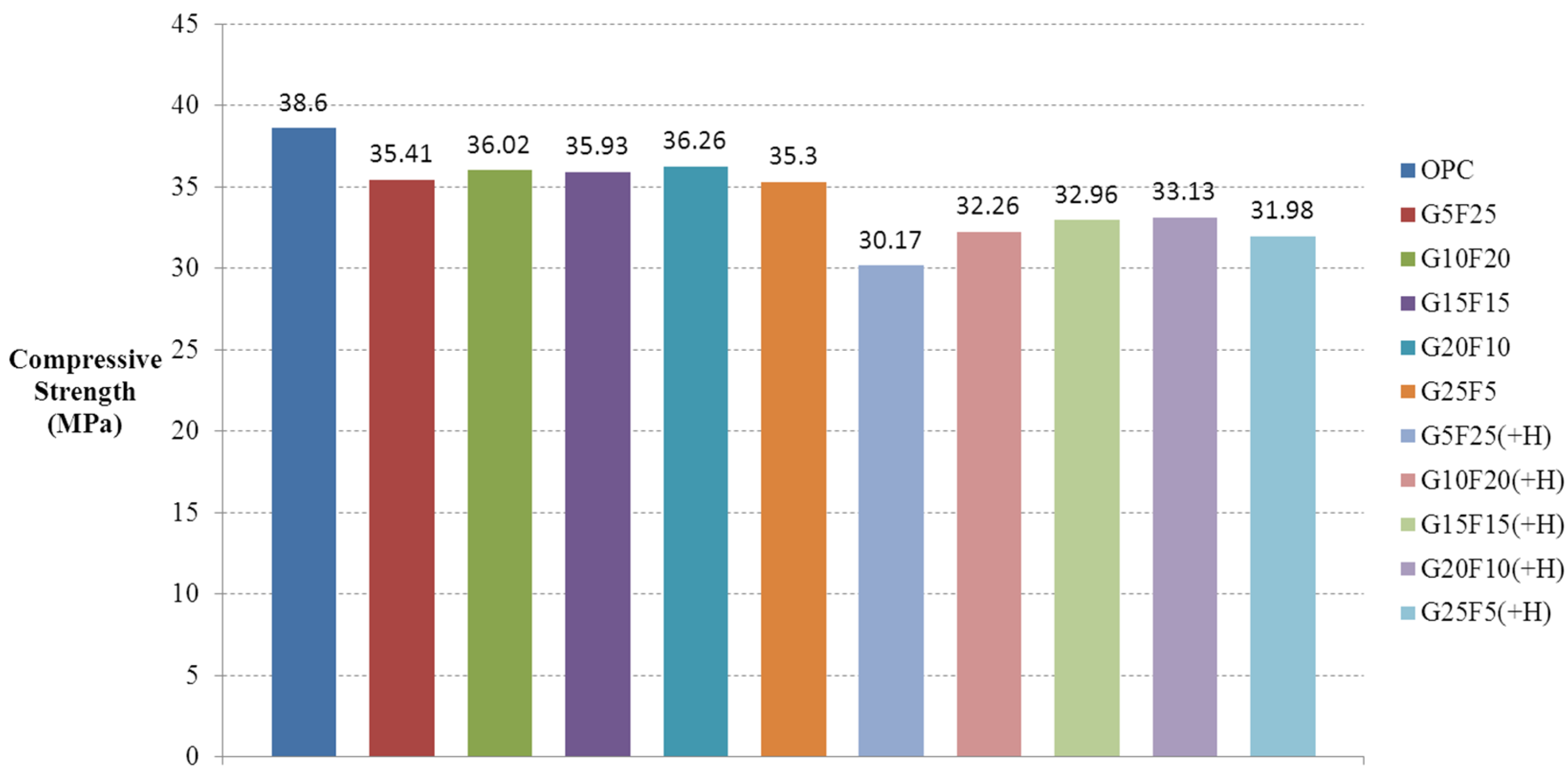
2.5. pH

3. Health Benefit Assessment of Activated Hwangtoh Mixed Concrete
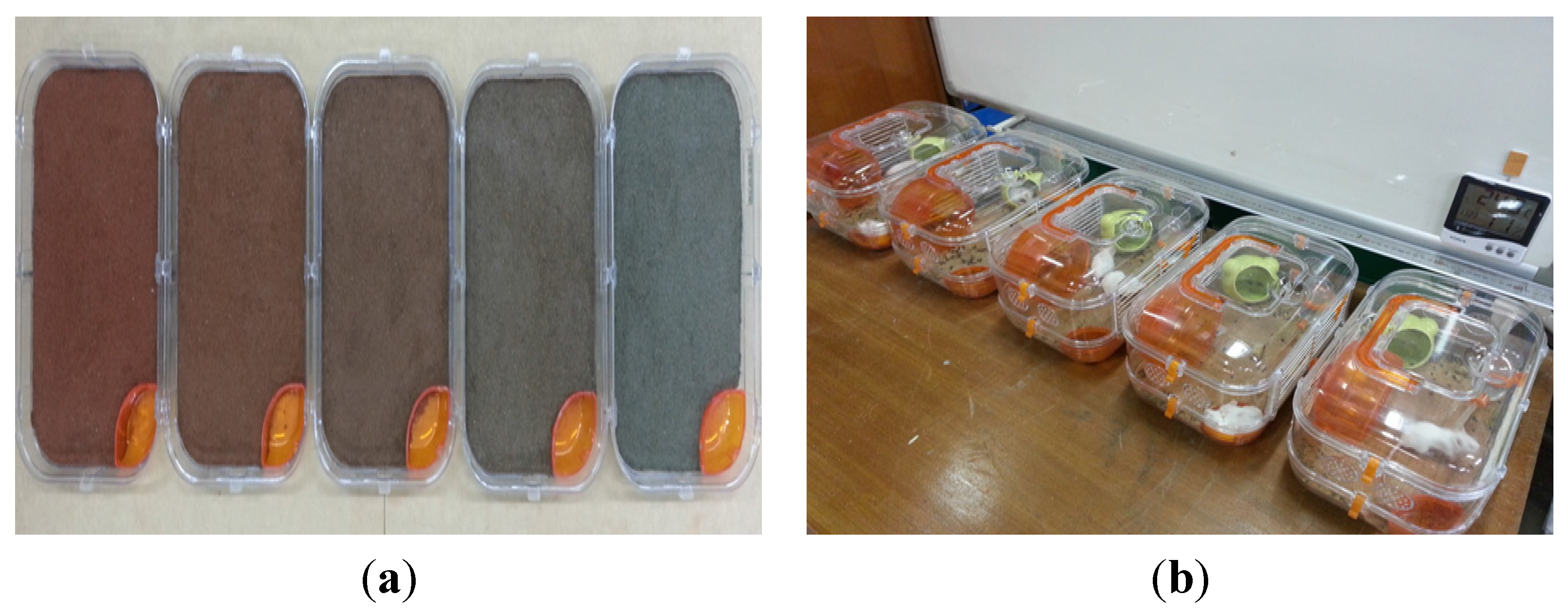
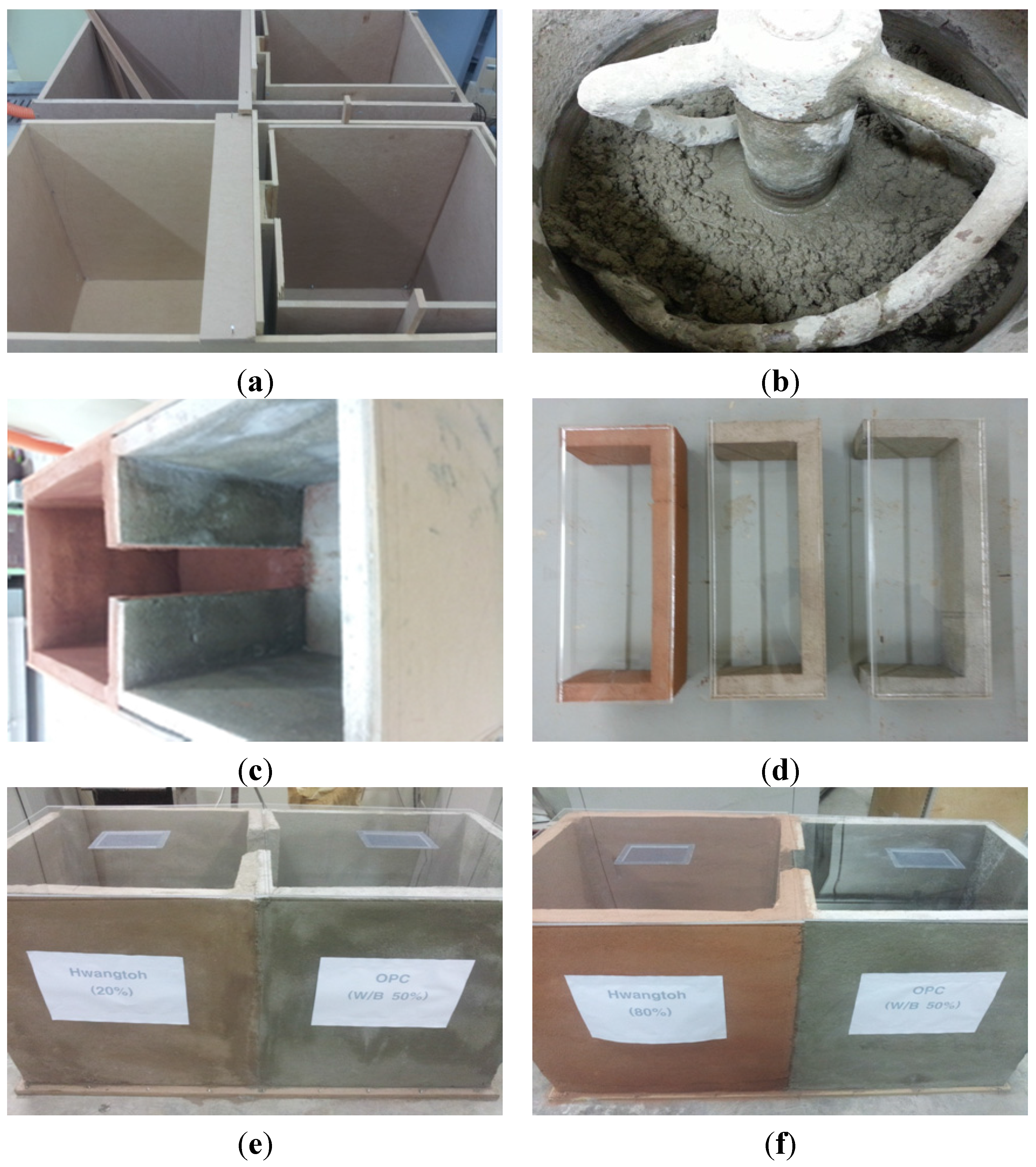
4. Temperature and Humidity Changes Depending on Mixture Ratios
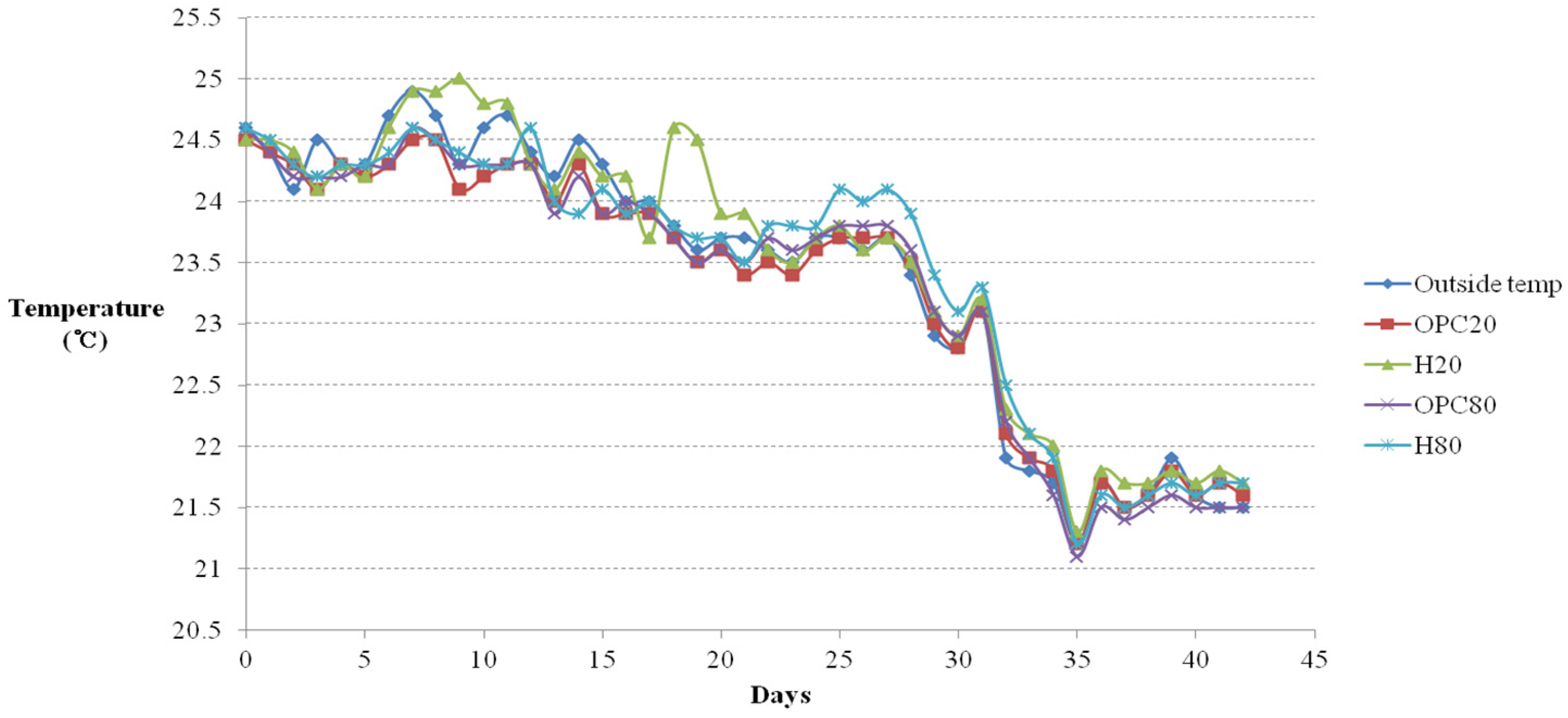
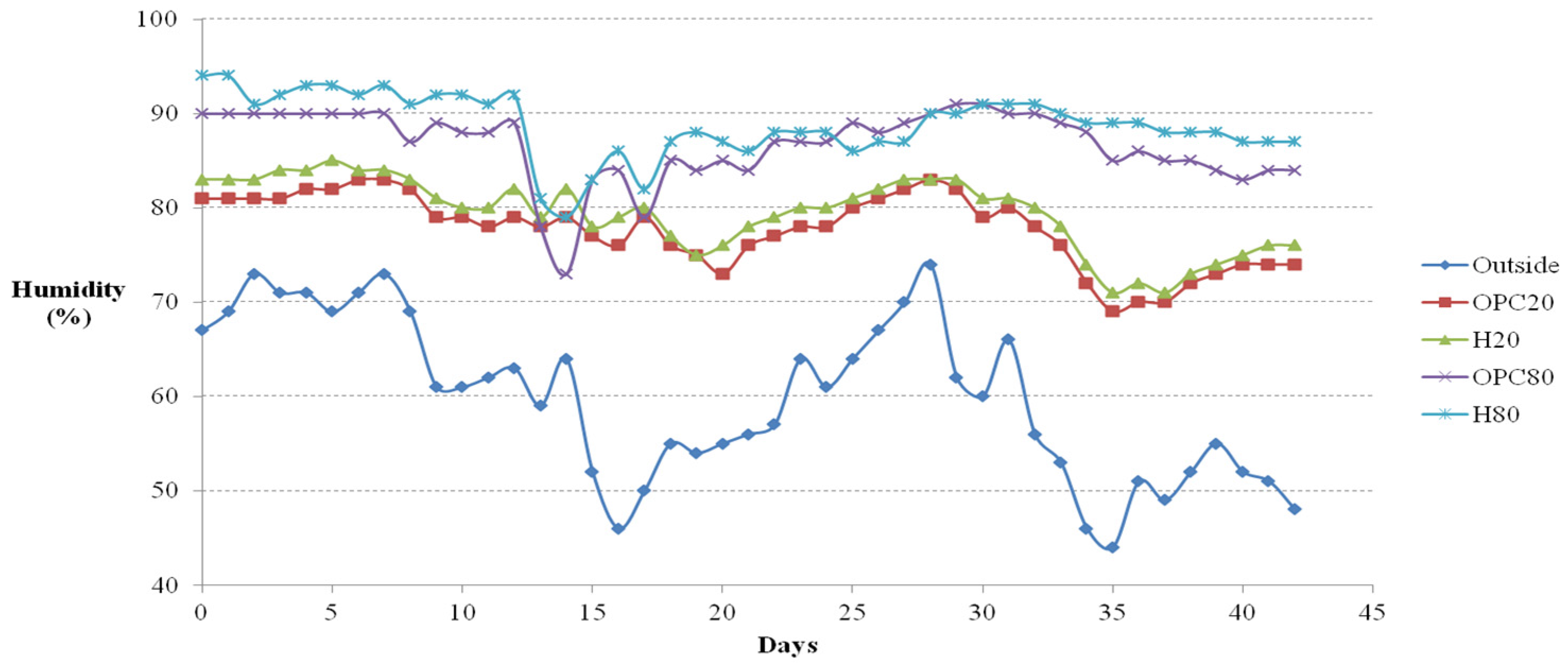
4.1. Amount of Food and Water Intake
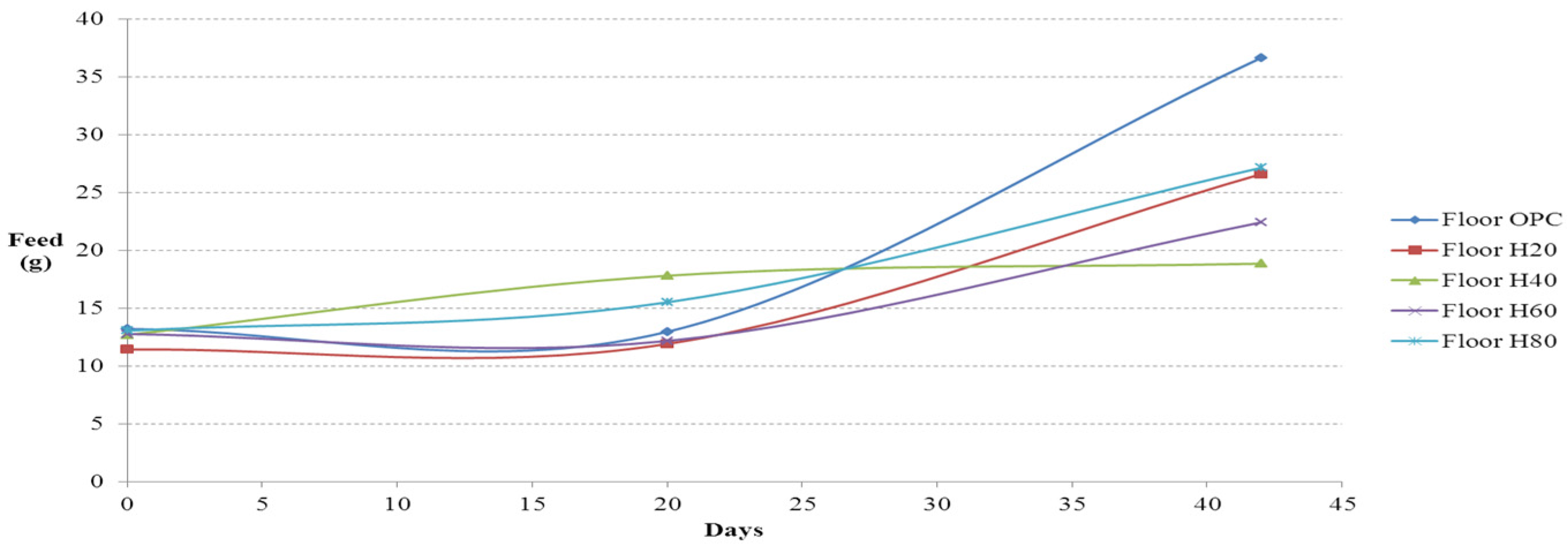
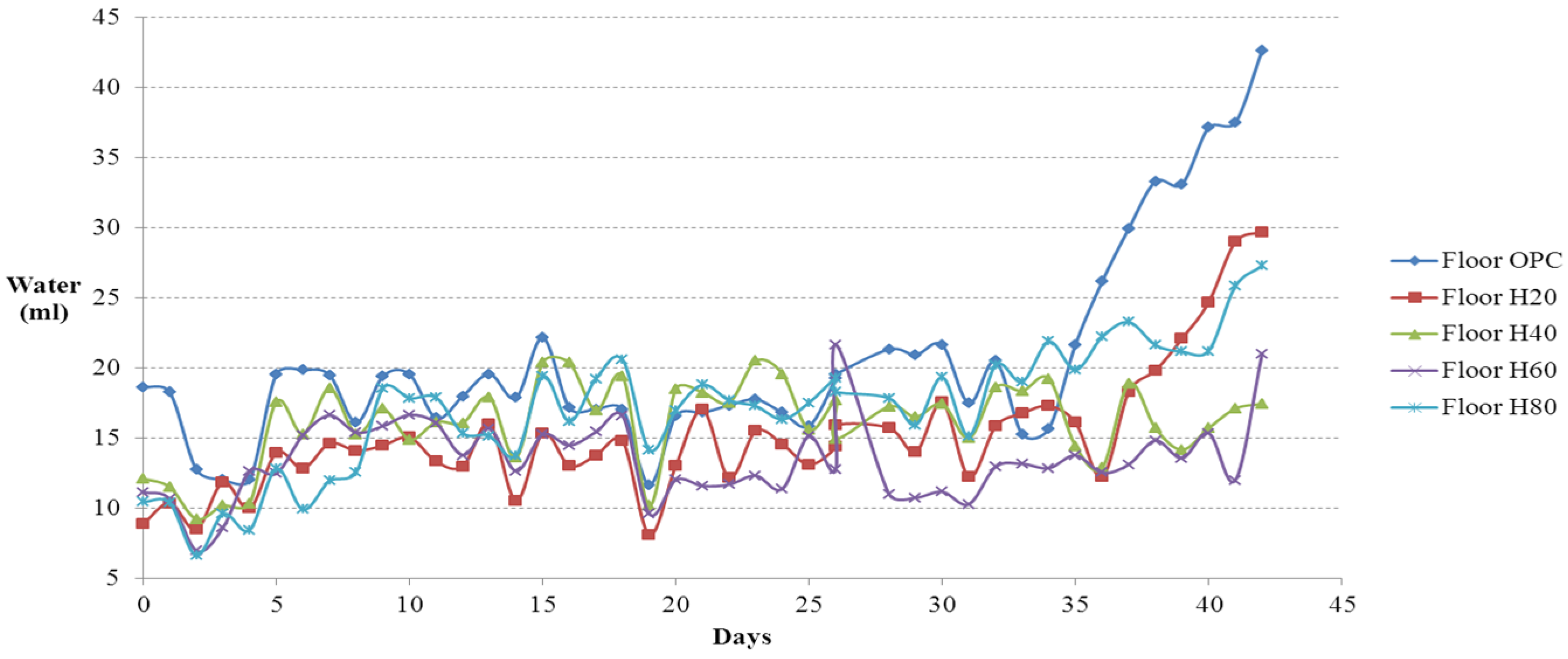

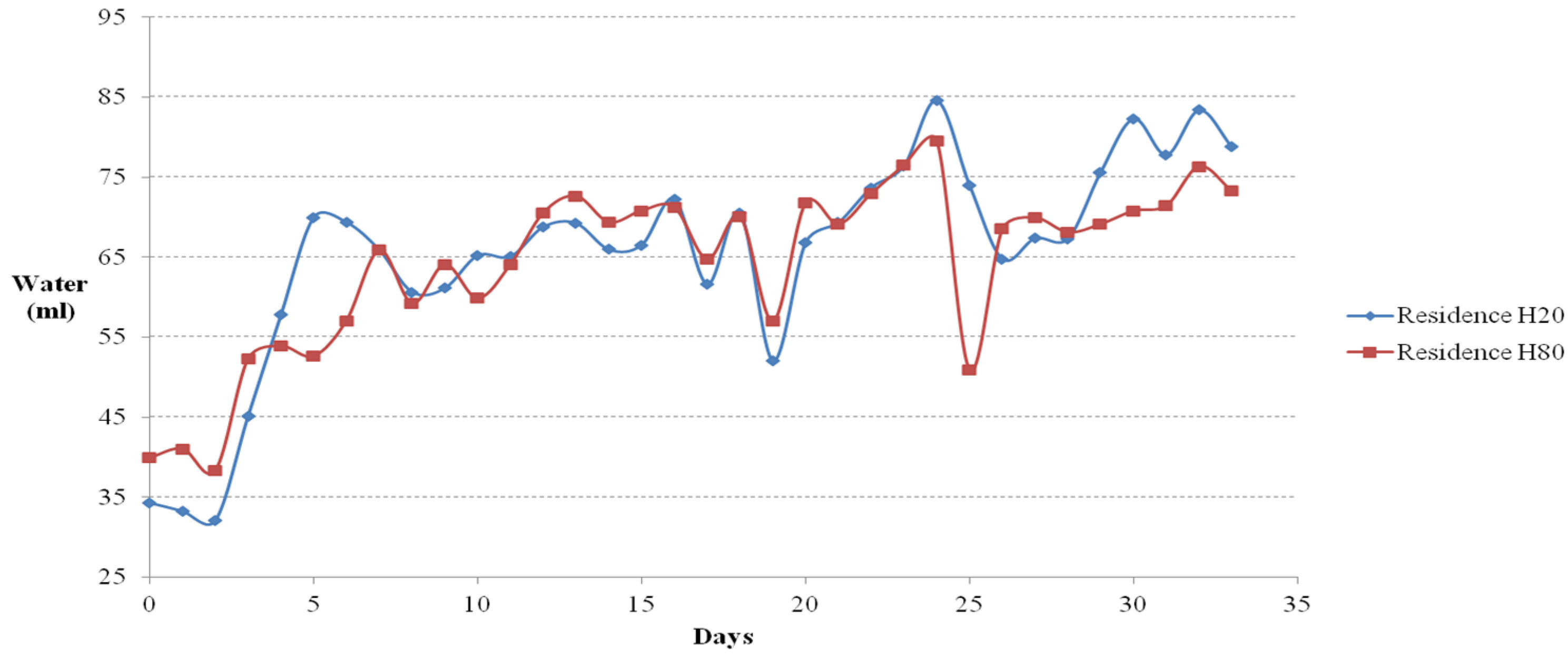
4.2. Weight Gain
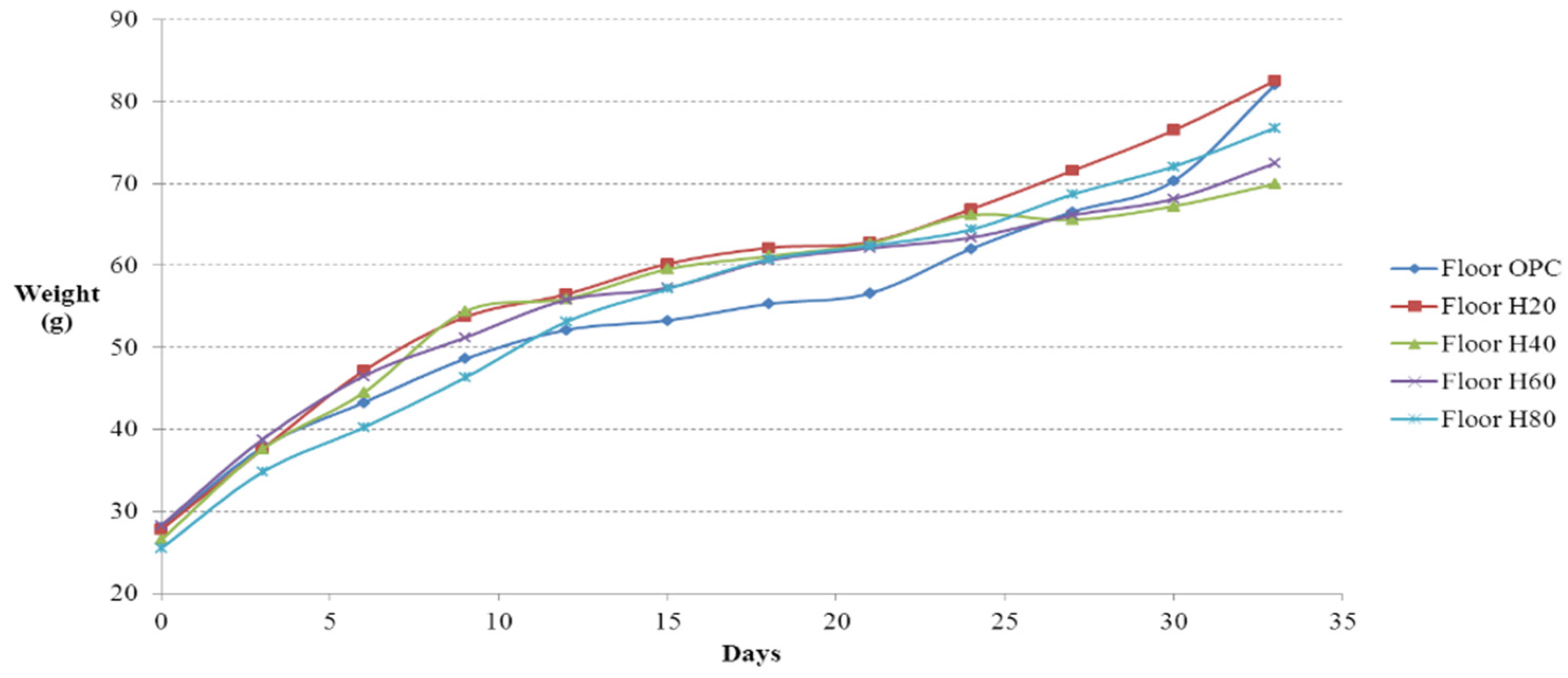

5. Aggression

Fertility Rate
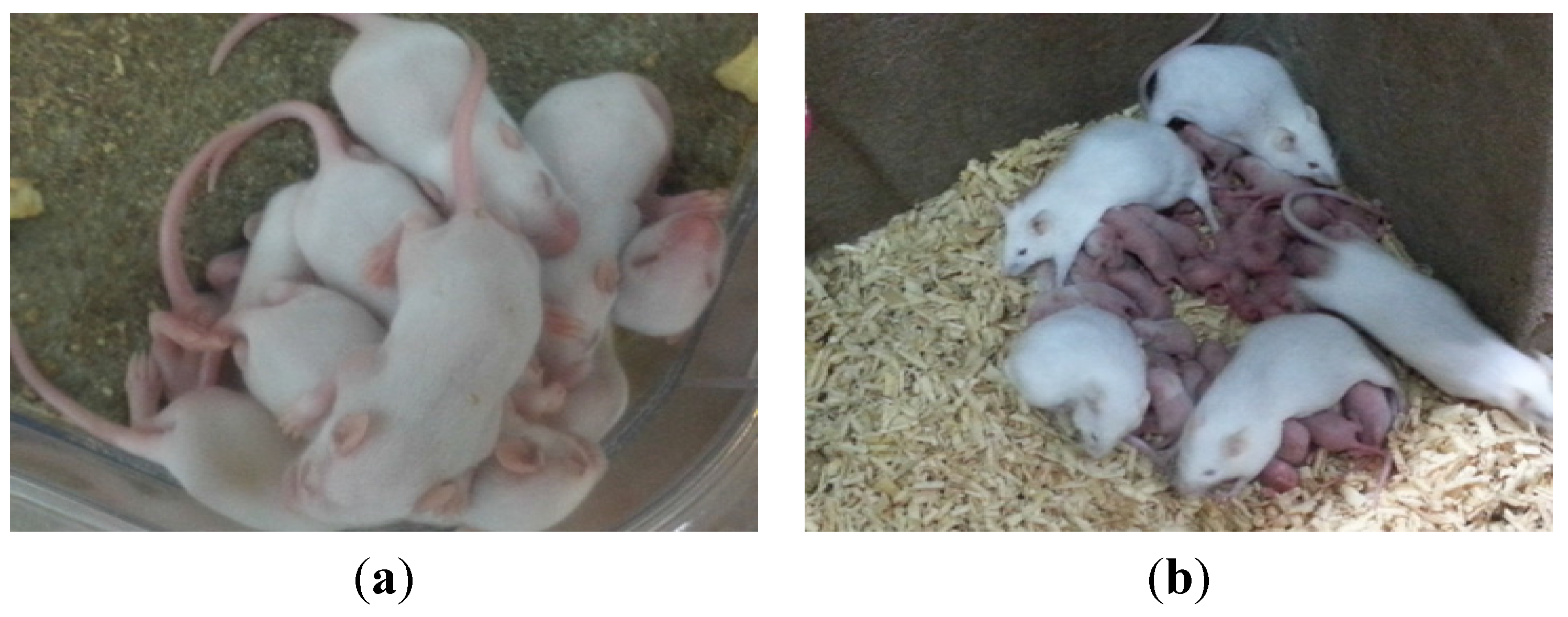


6. Residential Environment Selection
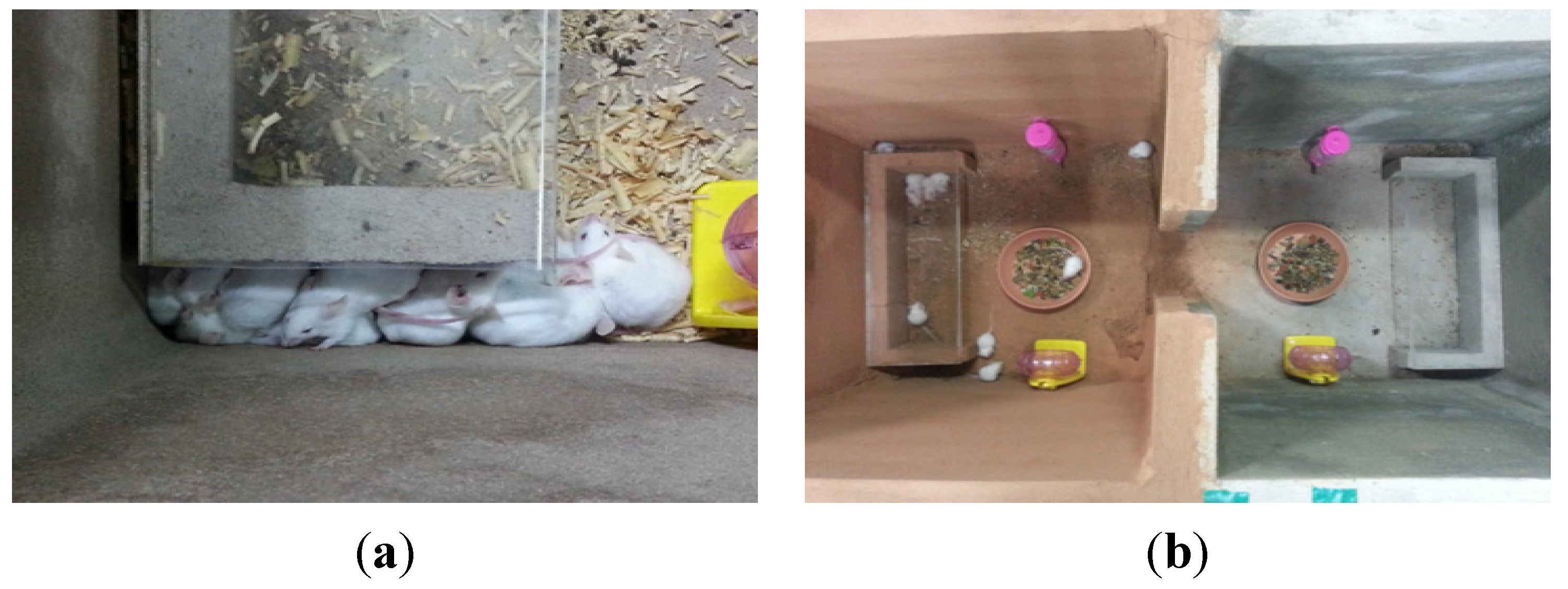
7. Conclusions
- (1)
- Although the activated Hwangtoh mixed concrete showed slightly lower compressive strength than the ordinary concrete, it is a suitable construction material, except in those cases that require exceptionally high strength and durability.
- (2)
- Because the activated Hwangtoh mixed concrete tended to absorb more water, the optimal addition rate of superplasticizer for better workability was 1.5 volume %.
- (3)
- The pH of the activated Hwangtoh mixed concrete was lower than that of ordinary concrete.
- (4)
- The differences in temperature and relative humidity between OPC mortar and Hwangtoh cement mortar measured from the residence selection casts were 0.1 °C–1.5 °C and 1.0%–5.0%, respectively.
- (5)
- The amount of food and water intake by the mice in the activated Hwangtoh environment was considerably higher than that in the OPC environment. Also, the mice in the activated Hwangtoh environment had a higher fertility rate and healthier offspring.
- (6)
- The ICR mice moved to the ordinary cement cast only for food and water. At all other times, they stayed in the activated Hwangtoh living quarter.
Acknowledgments
Author Contributions
Conflicts of Interest
References
- Hwang, J.P.; Hong, S.I.; Yang, H.J.; Ann, K.Y. Evaluation on hexavalent chromium content in loess additive as a inhibitive material to leachat of heavy metal. Proc. Korea Concr. Inst. 2013, 25, 281–282. [Google Scholar]
- Lee, J.H.; Park, N.K.; Jung, Y.J.; Chu, Y.S.; Song, H.; Lee, J.K. Leaching Properties of Hexavalent Chromium in Sintering Condition of Clinker Material. Proc. Korea Concr. Inst. 2008, 20, 549–552. [Google Scholar]
- Hwang, H.Z. Study on the Method of Activating Kaoline and the Mortar and Concrete Mixed with Active-Kaoline. Ph.D. Thesis, The Seoul National University, Seoul, Korea, February 1997. [Google Scholar]
- Yang, K.H.; Hwang, H.Z.; Kim, S.Y.; Song, J.K. Development of a Cementless Mortar Using Hwangtoh Binder. Build. Environ. 2007, 42, 3717–3725. [Google Scholar] [CrossRef]
- Go, S.S.; Lee, H.C.; Lee, J.Y.; Kim, J.H.; Chung, C.W. Experimental Investigation of Mortars Using Activated Hwangtoh. Constr. Build. Mater. 2009, 23, 1438–1445. [Google Scholar] [CrossRef]
- Dinakar, P.; Sahoo, P.K.; Sriram, G. Effect of Metakaolin Content on the Properties of High Strength Concrete. Int. J. Concr. Struct. Mater. 2013, 7, 215–223. [Google Scholar] [CrossRef]
- Choi, H.Y.; Kim, M.H.; Hwang, H.Z. Study on the Development of Hwangtoh Admixture for the Application of Cement Mortar. J. Archit. Inst. Korea 2000, 16, 95–102. [Google Scholar]
- Choi, H.Y.; Kim, M.H.; Hwang, H.Z.; Choi, S.W. Experimental Study on the Properties of Concrete by the Kinds of Admixture and the Replacement Ratios of Activated Hwangtoh. J. Korea Concr. Inst. 2001, 13, 672–675. [Google Scholar]
- Becknell, N.P.; Micah-Hale, W. Effect of Slag Grade and Cement Source on the Properties of Concrete. Int. J. Concr. Struct. Mater. 2011, 5, 119–123. [Google Scholar] [CrossRef]
- Frisa, M.; Sanchez de Rojas, M.I.; Cabrerab, J. The Effect That the Pozzolanic Reaction of Metakaoline has on the Heat Evaluation in Metakaoline-Cement Mortars. Cem. Concr. Res. 2000, 30, 209–216. [Google Scholar] [CrossRef]
- Go, S.S.; Chung, C.W.; Struble, L.J.; Lee, H.C. Pozzolanic Activity of Hwangtoh Clay. Constr. Build. Mater. 2010, 24, 2638–2645. [Google Scholar] [CrossRef]
- Lee, N.K.; Hwang, H.Z.; Park, H.G. Flexural Performance of Activated Hwangtoh Concrete Beam. J. Korea Concr. Inst. 2010, 22, 567–574. [Google Scholar] [CrossRef]
- Yang, K.H.; Hwang, H.Z.; Kim, S.Y.; Song, J.G. Effect of Superplasticizers and Admixtures on the Fluidity and Compressive Strength Development of Cementless Mortar Using Hwangtoh Binder. J. Korea Concr. Inst. 2006, 18, 793–800. [Google Scholar]
- Bougara, A.; Kadri, E.; Ezziane, K. Efficiency of Granulated Blast Furnace Slag Replacement of Cement According to the Equivalent Binder Concept. Cem. Concr. Compos. 2010, 32, 226–231. [Google Scholar]
- Kang, H.K.; Yang, K.H.; Lee, Y.H.; Hwang, H.Z.; Chung, H.S. The Stress-Strain Relationship and Compressive Strength of Concrete Containing Hwangtoh and Slag. Korea Concr. Inst. Conf. 2004, 16, 672–675. [Google Scholar]
- Lee, S.H.; Choi, I.C.; H, S.K. Analysis on the Harmful Effect of Recycled Powder and Properties of Concrete Admixture by Recycled Powder. J. Korea Soc. Mar. Environ. Saf. 2008, 14, 289–295. [Google Scholar]
- Chun, B.S.; Kim, J.C. Evaluation of Toxic Effect of Grouting Materials by Fish Poison Test. J. Korea Soc. Civ. Eng. 1998, 18, 531–538. [Google Scholar]
- Funase, S. Concrete Stress. Matibook 2002, 17–40. [Google Scholar]
- Ghebrab, T.T.; Soroushian, P. Mechanical Properties of Cement Mortar: Development of Structure-Property Relationships. Int. J. Concr. Struct. Mater. 2011, 5, 3–10. [Google Scholar] [CrossRef]
- Lee, K.W.; Jang, J.H.; Choi, H.Y.; Goo, J.S.; Hwang, H.Z.; Kim, M.H. Experimental Study on the Resistance of Chloride Infiltration of Concrete Using Activated Hwangtoh Admixture. Proc. Korea Concr. Inst. 2001, 13, 781–786. [Google Scholar]
- Kang, S.S.; Lee, S.L.; Hwang, H.Z.; Cho, M.C. Hydration Heat and Shrinkage of Concrete Using Hwangtoh Binder. J. Korea Concr. Inst. 2008, 20, 549–555. [Google Scholar]
- Ghebrab, T.T.; Soroushian, P. Mechanical Properties of Hydrated Cement Paste: Development of Structure-Property Relationships. Int. J. Concr. Struct. Mater. 2010, 4, 37–43. [Google Scholar] [CrossRef]
- Murmu, M.; Singh, S.P. Hydration Products, Morphology and Microstructure of Activated Slag Cement. Int. J. Concr. Struct. Mater. 2014, 8, 61–68. [Google Scholar] [CrossRef]
- KS L ISO 679 Methods of Testing Cements—Determination of Strength; Korean Agency for Technology and Standards (KATS): Seoul, Korea, 2006; pp. 1–16.
- KS F 2401 Method of Sampling Fresh Concrete; Korean Agency for Technology and Standards (KATS): Seoul, Korea, 2007; pp. 1–7.
- KS F 2402 Method of Test for Slump of Concrete; Korean Agency for Technology and Standards (KATS): Seoul, Korea, 2007; pp. 1–5.
- KS F 2421 Method of Test for Air Content of Fresh Concrete by Pressure Method; Korean Agency for Technology and Standards (KATS): Seoul, Korea, 2006; pp. 1–17.
- KS F 2403 Standard Test Method for Making and Curing Concrete Specimens; Korean Agency for Technology and Standards (KATS): Seoul, Korea, 2014; pp. 1–7.
- KS L 5405 Flyash; Korean Agency for Technology and Standards (KATS): Seoul, Korea, 2009; pp. 1–6.
- KS F 2405 Standard Test Method for Compressive Strength of Concrete; Korean Agency for Technology and Standards (KATS): Seoul, Korea, 2010; pp. 1–6.
- Park, C.K.; Jeong, J.H.; Kim, H.J. pH Reduction of High Porous Concrete to Grow Plant. Proc. Korea Concr. Inst. 2001, 13, 1129–1134. [Google Scholar]
- Korea Food and Drug Administration. Law for Laboratory Animals; Korea Food Drug Administration: Seoul, Korea, 2010; pp. 63–64. [Google Scholar]
© 2015 by the authors; licensee MDPI, Basel, Switzerland. This article is an open access article distributed under the terms and conditions of the Creative Commons Attribution license (http://creativecommons.org/licenses/by/4.0/).
Share and Cite
Koo, B.-M.; Kim, J.-H.J.; Kim, T.-K.; Kim, B.-Y. Material Performance and Animal Clinical Studies on Performance-Optimized Hwangtoh Mixed Mortar and Concrete to Evaluate Their Mechanical Properties and Health Benefits. Materials 2015, 8, 6257-6276. https://doi.org/10.3390/ma8095306
Koo B-M, Kim J-HJ, Kim T-K, Kim B-Y. Material Performance and Animal Clinical Studies on Performance-Optimized Hwangtoh Mixed Mortar and Concrete to Evaluate Their Mechanical Properties and Health Benefits. Materials. 2015; 8(9):6257-6276. https://doi.org/10.3390/ma8095306
Chicago/Turabian StyleKoo, Bon-Min, Jang-Ho Jay Kim, Tae-Kyun Kim, and Byung-Yun Kim. 2015. "Material Performance and Animal Clinical Studies on Performance-Optimized Hwangtoh Mixed Mortar and Concrete to Evaluate Their Mechanical Properties and Health Benefits" Materials 8, no. 9: 6257-6276. https://doi.org/10.3390/ma8095306





